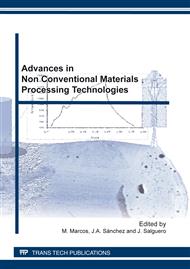p.61
p.67
p.73
p.79
p.85
p.91
p.97
p.103
p.109
Geometry Modelling of Clads Generated by Laser Cladding
Abstract:
The laser cladding process is based on the generation of a melt-pool in a substrate where a filler material is injected, generating a high quality clad with a minimum heat affected zone. This process is industrially used to generate coatings over wear or damaged surfaces, being an alternative to traditional deposition techniques. One of the most important aspects for its industrial application is to know the clad geometry in order to calculate the deposited layer thickness. This work presents a model in which, starting from the concentration of injected material and the melt-pool geometry, clad height is finally estimated. Both input variables are obtained by two previous validated models. On one hand, the melt pool is estimated by a thermal model based on the finite difference method, and on the other hand, concentration of injected material is provided by a particle concentration CFD model. This data is used in a mass balance over melt-pool area in order to estimate the deposited clad height.
Info:
Periodical:
Pages:
85-90
Citation:
Online since:
February 2012
Authors:
Keywords:
Price:
Сopyright:
© 2012 Trans Tech Publications Ltd. All Rights Reserved
Share:
Citation:


